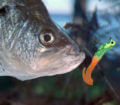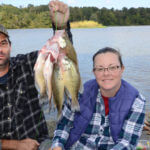Editor’s Note: In late spring and summer, you can catch crappie in many unorthodox ways, including fishing with knitting thread, fake hair or fur, jugging, goldfish, chumming and egging to name a few tactics. This week we’ll look at fishing strategies you can use for crappie that you’ve probably never considered.
During the spawn, crappie often spawn so far under a dock that you can’t cast to them. To solve this problem, use a small, 4-1/2- to 5-foot light-action spinning rod and 4- to 6-pound test line. Leave about 3 feet of line hanging down from the end of the rod. Pick up the line closest to the reel with you index finger, and hold the line with your finger like you’re preparing to cast. With your other hand, take hold of the jig between your thumb and index finger with the hook pointing away from you. Pull the jig back, so that the rod bends. Aim the rod under the dock, and release the jig. Just as the jig clears the end of the rod, release the line you’re holding with your finger on the other hand. The rod then will shoot the jig under the dock where you can’t cast. Once the jig hits the water, begin a slow, steady retrieve to catch big crappie in a place where few crappie fishermen fish.
Fishing Beaver Sticks for Big Crappie:
An elderly crappie-fishing friend of mine, used what he called beaver sticks to find and catch big crappie during the spawn. “A beaver stick is a pole that’s from 4- to 6-feet long that beavers have gnawed all the bark away from,” he told me. “I’ll take 10 to 12 beaver sticks and stick them up in the bottom off the bank near a spawning area. Then during the prespawn, the spawn and immediately after the spawn, I usually catch the biggest crappie of the year by drop fishing minnows right beside each beaver stick. Each stick will hold only one or two slab crappie. But the size of crappie I catch, and the numbers of days I can fish those beaver sticks and catch new crappie makes my effort worthwhile. Big crappie like isolated cover offshore where they can hold and go to the bank and come away from the bank and hold during the spawn.”
If you fish ponds and lakes no more than 6-7 feet deep with cypress trees in them off the main river channel, you may find a honey hole for hot-weather crappie fishing. The roots of a cypress tree will form a doughnut shape around the tree below the water’s surface. Crappie will hold in the doughnut shape of these roots, even in 100-degree weather. By dropping minnows or jigs around the base of the tree and around the outside root balls, you can find and catch crappie in this shallow water or even in hot weather.
To learn much more about crappie fishing, get John E. Phillips’ Kindle eBooks, and print and Audible books by going to https://johninthewild.com/books/#crappie or to www.barnesandnoble.com.
To receive and download for free “The Crappie Catchers’ Cookbook,” by John and Denise Phillips, go to https://johninthewild.com/free-books.












